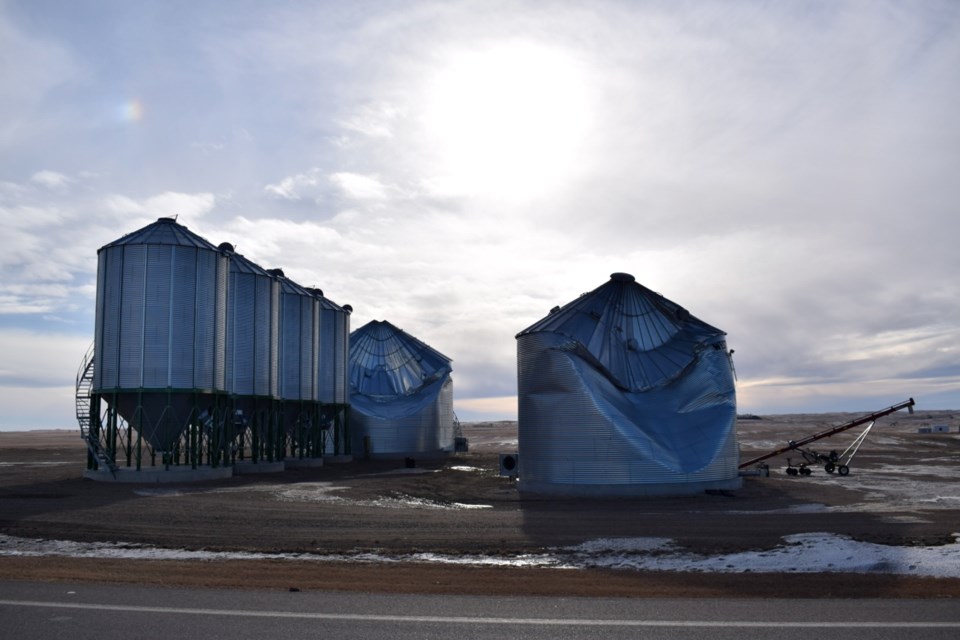Southeast Saskatchewan residents have been cleaning up ever since a powerful winter storm battered the region late on Jan. 13 and early on Jan. 14.
The Alberta clipper packed wind gusts that reached about 120 kilometres per hour, and whipped around snow that created near-zero visibility. Power was knocked out to many, travel not recommended advisories were issued through the southeast early on Jan.14, and some highways were closed.
Trees were toppled, branches were snapped and homes were damaged.
The storm roared throughout southern and central Saskatchewan as well, knocking out power to an estimated 100,000 homes at one point. Electricity was restored to most in the province on Jan. 14, but others, including some in the southeast, weren’t restored until early Jan. 15. The final homes had power restored on Jan. 16.
Insurance companies are expected to be busy in the coming weeks due to all of the damage.
Troy Smith, who resides in the south set of cabins along Boundary Dam, said that roof over his vaulted ceiling was pulled off the north side of the house.
“The ceiling’s made out of pine,” he told the Mercury. “That stayed in place. So we weren’t open to the outside. We just had no insulation and a lot of wind blowing into the house. But it wasn’t snowing in here, so to say.”
The roof split in two. One side flipped and landed on his sports utility vehicle and just missed his wife’s SUV. He expects his vehicle will be a write-off.
The other half of the roof landed on the neighbour’s roof, put a hole in it, and then landed in the neighbour’s driveway. The neighbours were pretty understanding about the incident.
Repairs will be pretty significant, he said. They haven’t received any quotes yet. In the meantime, a temporary roof is in place until something can be repaired.
Also damaged was the roof of a 30-foot by 60-foot pole shed.
“The roof is laying on top of my motorhome that was inside the shed. I haven’t started digging that one out yet, either.”
Smith has never experienced winds like that before during the 13 years that his family has resided along the dam. They get some pretty good gusts coming off the lake, that might be around 100 kilometres per hour. He believes the winds on Jan. 14 might have reached 140 kilometres per hour.
Another family, Jason Stepp, has been busy cleaning up the destruction after a trailer home on the Torquay-area farm rolled and smashed at the height of the storm.
Stepp’s farmhand had just laid down on his couch with his dog when the winds caused the home to roll three full times before smashing into one of Stepp’s shops.
He said the shop was the only thing to stop the trailer, noting that insulation from the smashed-up trailer was found at a neighbour’s farm five kilometres away.
“It was the ugliest wind I’ve ever heard,” said Stepp, noting the farmhand’s bed was found about 600 to 800 feet away, while his own truck was pushed across the ice to some trees.
Somehow the farmhand survived the ordeal and crawled out, and went into the shop to get out of the storm. His dog also survived the ordeal, and came up to the farm house for help.
Afterward, Stepp said he found kitchen knives stuck into the floor like they were thrown there.
The trailer home had just been fixed up, with about $50,000 spent to upgrade it as a residence for the farm worker, and he lost everything when the home was smashed up.
In addition, among the other damages on the farm, some of Stepp’s grain bins were damaged, so the 100,000-bushel capacity he formerly had is now down to 25,000 bushels, and he’s worried whether he will have grain storage space come harvest time.
By his estimate, Stepp figures he’s looking at upwards of a $1 million in damages on the farm. Insurance adjustors were due to pay a visit to the farm on Jan. 16 and have a look at the damages.
As for the big mess left by the storm, Stepp said, “We’re a hard-working crew and we’ll get it done. We’ve got a good crew here and we’ll clean it up.”
Rod March, the parks manager for the City of Estevan, said he saw damage across the city, with broken branches. A couple of trees the city owns were down, but they were coniferous trees, which are shallowed-rooted, spruce trees.
Pruning will be needed on some of the other trees.
“Being winter time, these … trees don’t have leaves on them,” said March. “But they are more brittle, because they’re frozen. So you’re going to get some cracking of branches. But in the summer storms, when the leaves are on them, there’s a lot higher stress, so that’s when we see the trees coming down, because there’s no frost holding them in the ground.”
He saw trees down on private land as well.
“There was debris scattered throughout the city. I’ll say most of that is garbage or fence panels or shingles, all that sort of thing. All of our litter containment systems tipped over, so the parks staff right now are picking all that up and straightening it.”
Two dugouts at the Pleasantdale Softball Diamonds were damaged, but March expects they will be ready for the start of the season in the spring. The roof blew off another dugout at the Lynn Prime Park baseball diamonds.
The dugouts were built properly, he said.
“There’s been a lot of damage to private dwellings that I saw around the city, and people are dealing with that, but the city’s infrastructure held up pretty well,” said March, who thanked everyone who called in about the damage in the city.



